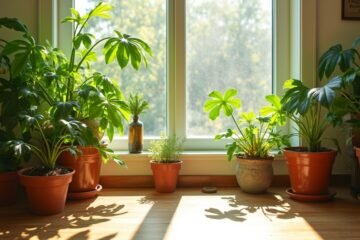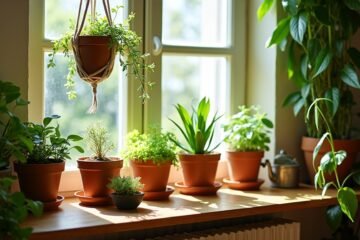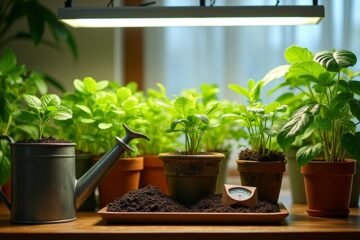Transform your small apartment into a green paradise with a few savvy strategies! Start by choosing low-light plants, like snake plants and pothos, that thrive in dim corners. Consider vertical gardening by using wall planters or hanging baskets, turning your walls into lush art! Welcome multifunctional furniture; imagine a coffee table packed with vibrant herbs! Don’t forget to mist your leafy friends for that tropical vibe! Stick around to discover more on making your indoor garden flourish!
Selecting the Right Plants for Limited Light
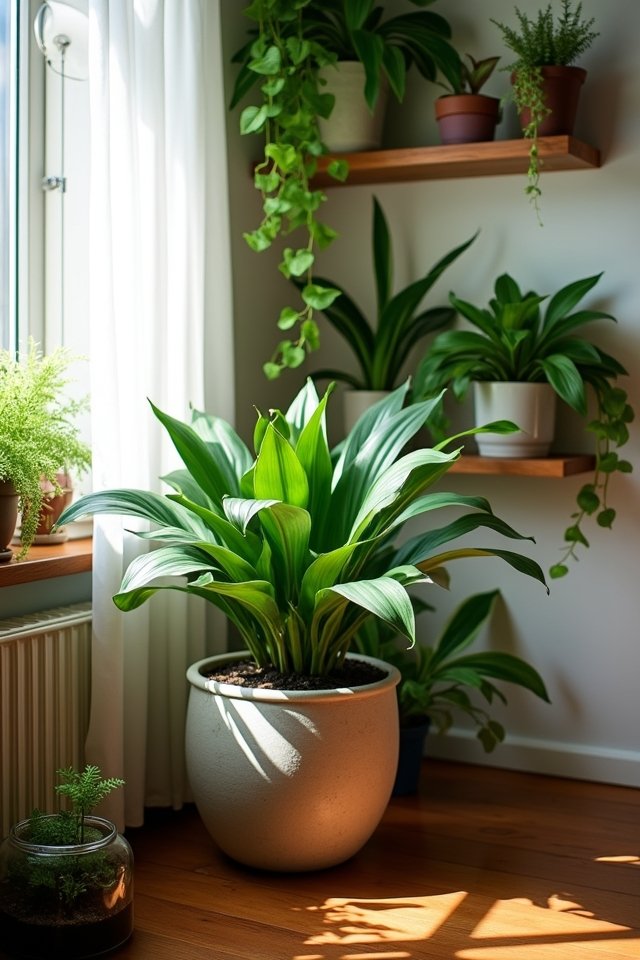
Do you find yourself gazing longingly at lush houseplants while your own space feels a bit too dim? Don’t fret! You can welcome low light plants that thrive even in cozy corners. Think of a hardy snake plant or a cheerful pothos, both providing vibrant green to your indoor jungle! They’re like the trusty sidekicks of the plant world—resilient and easy to care for. Just remember, these fellow residents enjoy a good drink but don’t overwater them; they prefer a sip over a splash! With proper plant care, your home will transform into a thriving oasis. So why not take the plunge? Add these beauties to your collection and watch your apartment bloom with life!
Vertical Gardening Techniques
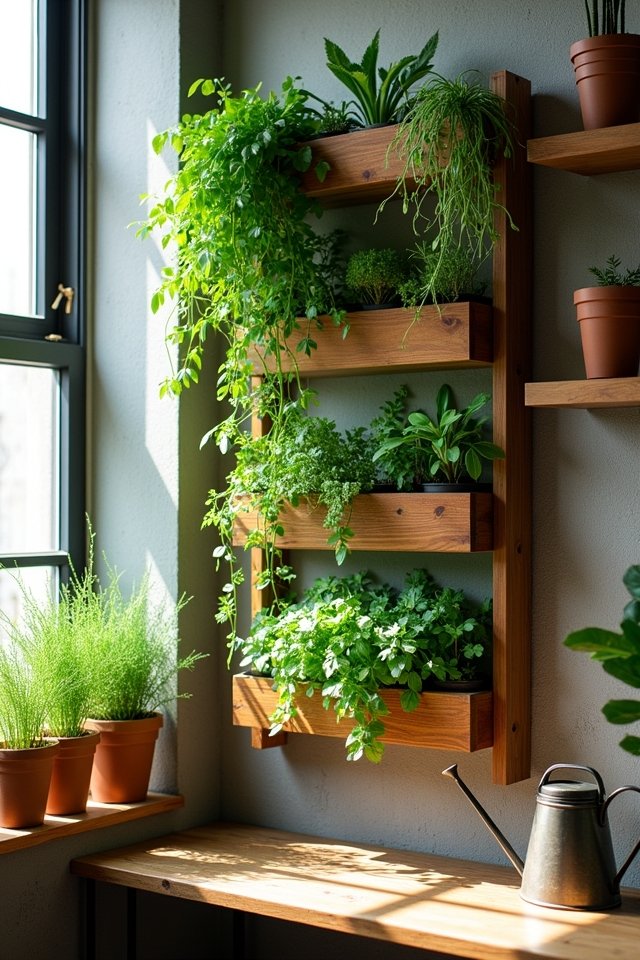
Ready to take your indoor gardening game to new heights? Vertical gardening techniques are your ticket to transforming empty walls into lush green landscapes! Imagine wall planters bursting with vibrant herbs, trailing vines, and colorful flowers. You can create a breathtaking vertical space that not only saves room but also adds life to your apartment. Use sturdy shelves or DIY pockets to hold your plants, and hang them strategically to soak up sunlight. Consider using lightweight pots to make your wall feel airy and open. Got a sunny spot? Try cascading plants to create a waterfall effect! With a little creativity, you’ll feel like a gardening magician, conjuring beauty from every inch of your home! Let’s grow upward!
Utilizing Multi-Purpose Furniture for Planters
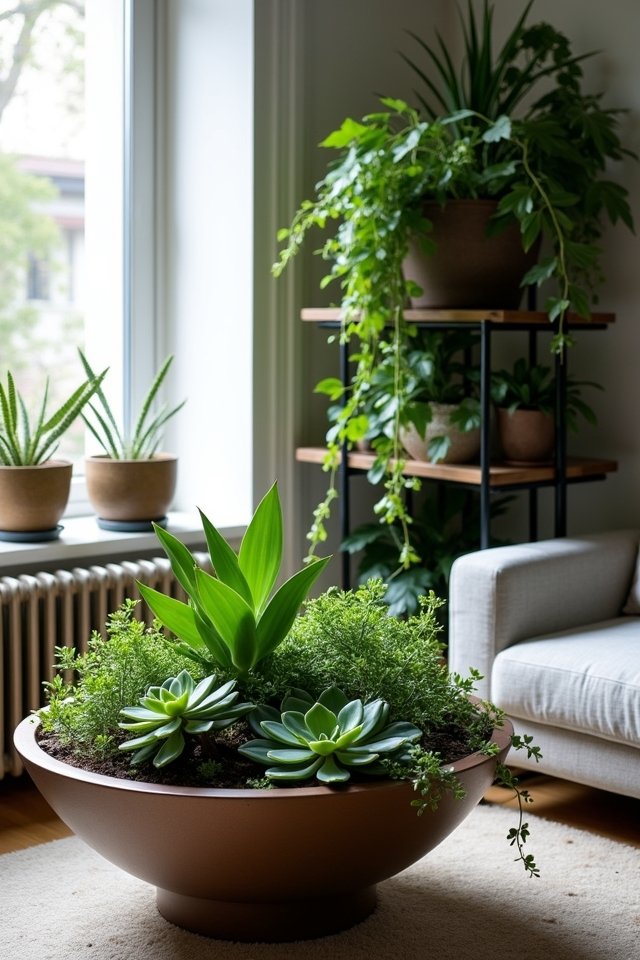
In a world where space is often at a premium, why not turn your furniture into a green oasis? Imagine a chic coffee table with built-in planters, bringing vibrant herbs right to your fingertips! With innovative furniture designs, you can easily meld style and function. Think about a comfy bench that doubles as a planter—perfect for trailing vines to drape beautifully over the sides. Or a bookshelf that houses your favorite succulents, creating a living piece of art! These clever planter integrations not only enhance your space but also spark joy with every glance. Who wouldn’t smile at a cozy armchair rocking a lush potted fern? Your small apartment can flourish with creativity while keeping the clutter at bay!
Creative Use of Window Sills and Balconies
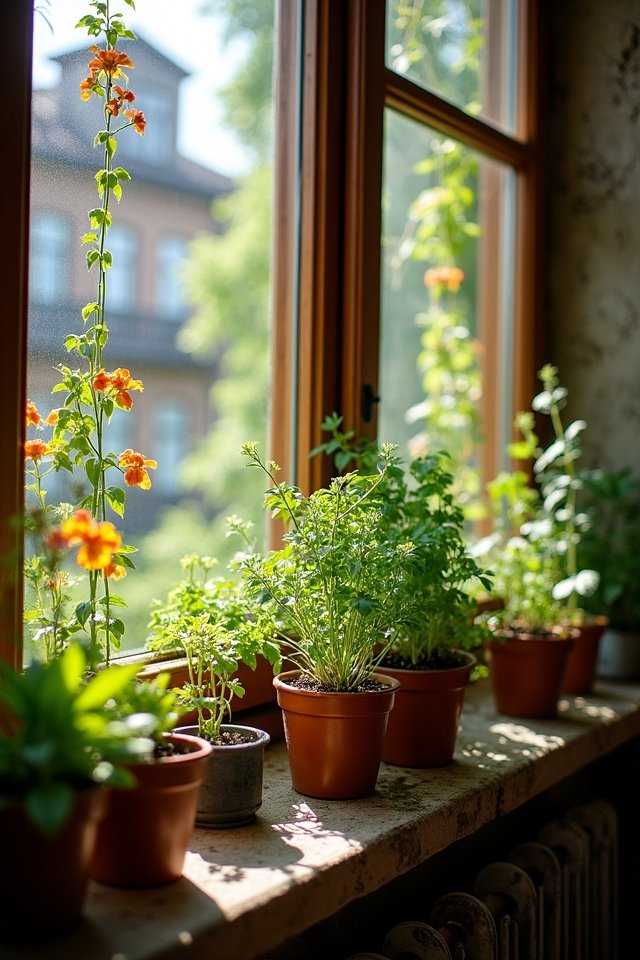
While you might think window sills and balconies are just for taking in the view, they’re actually perfect spots for your mini garden! Picture vibrant flowers spilling over the edges, creating stunning window decorations that steal the show. You can transform your balcony aesthetics with hanging planters, filled with herbs or colorful blooms, making your outdoor space feel like a lush oasis.
Use succulent arrangements in funky pots to add personality, or why not try a vertical garden to save space? You’ll love the fresh scents wafting through your apartment. Just imagine sipping coffee among your thriving greens! Don’t underestimate these small spaces; with a dash of creativity, they can be your garden’s pride and joy!
Indoor Herb Gardens in Small Spaces
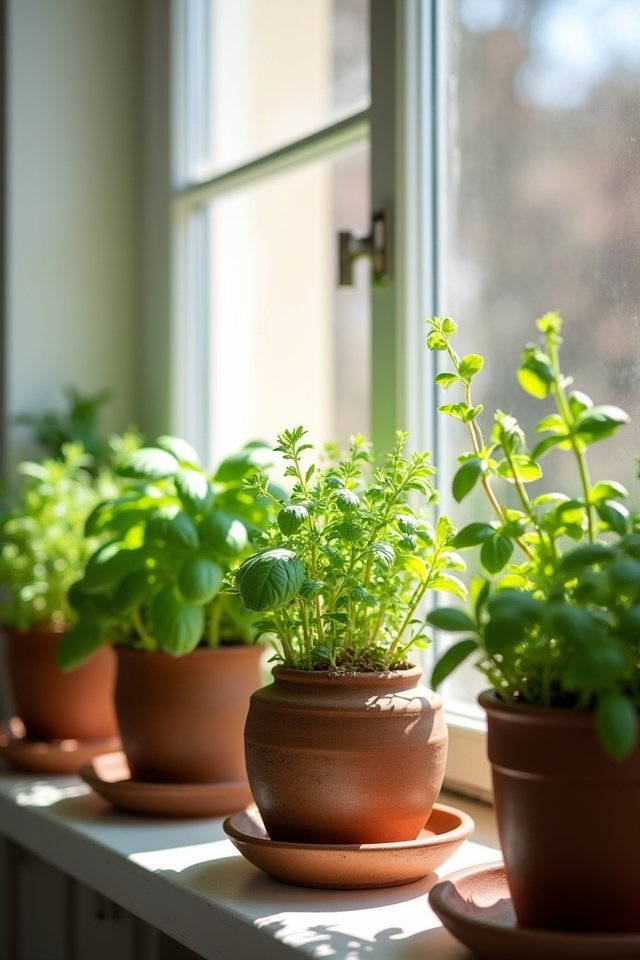
When you think about cooking with fresh flavors, nothing beats the joy of snipping herbs straight from your indoor garden! Creating an indoor herb garden in your small space can be a game-changer. Here’s how to get started:
- Choose your herb varieties: Basil, parsley, mint, and thyme are fantastic options.
- Select container options: Look for stylish pots, mason jars, or even repurposed teacups—get creative!
- Maximize your space: Use vertical shelving or hang planters near a sunny window.
- Stay innovative: Group herbs by watering needs to guarantee they thrive harmoniously!
There’s something magical about the scent of fresh herbs wafting through your kitchen. So, grab your snippers and get growing! Who knew small spaces could bring such big flavors?
Maintaining Humidity and Air Quality
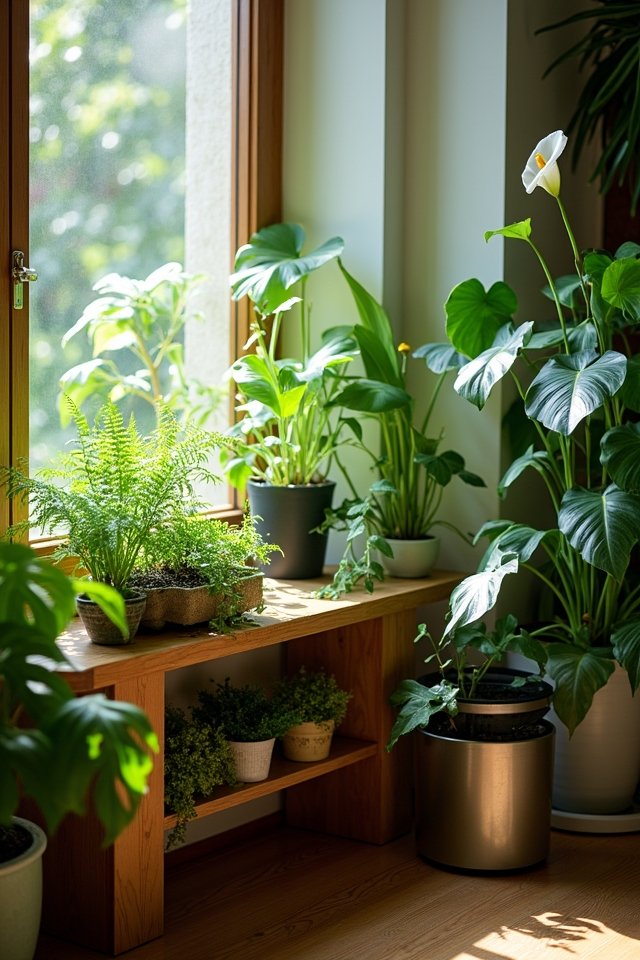
Your indoor herb garden might be thriving, but don’t forget that happy plants need the right environment too! To keep that green goodness flourishing, focus on maintaining humidity and air quality. Try misting techniques—like gently spritzing your herbs in the morning—just like a revitalizing morning dew! It’ll help those leafy beauties soak up essential moisture.
You can also set up humidity trays filled with water and pebbles beneath your pots. As the water evaporates, it creates a cozy little microclimate, perfect for herbs!
And don’t underestimate airflow—open a window now and then to let fresh air dance in. So, give your plants what they love, and watch them thrive like never before! Happy gardening!
Choosing the Best Soil and Fertilizers for Indoor Growth
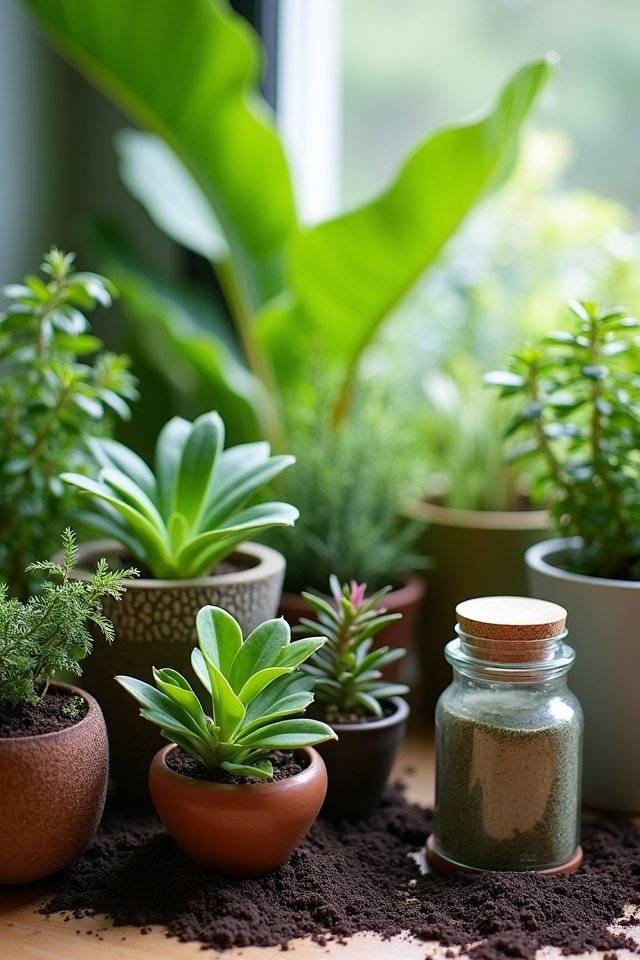
Have you ever wondered why some indoor plants seem to glow with health while others struggle? The secret lies in choosing the right soil and fertilizers! Here’s how you can give your green babies the best chance:
- Select the Right Soil Types: Use potting mix for most plants, while succulents crave cactus mix.
- Check Drainage: Make certain your soil drains well; soggy roots are a no-go!
- Choose Organic Fertilizers: Feed your plants with organic options like compost or worm castings for natural goodness.
- Adjust as Needed: Don’t be afraid to experiment! Your plants will appreciate the personalized care.
With these tips, your indoor garden will thrive, turning your apartment into a lush oasis! Happy planting! 🌱
Frequently Asked Questions
How Can I Prevent Pests in My Indoor Garden?
To keep pests at bay, you’ll want to adopt proactive pest control methods, trust me! Use natural repellents like neem oil or a mix of water with dish soap. Just spray those pesky critters away! You could also sprinkle diatomaceous earth—it’s like tiny glass shards for bugs. And hey, did you know that garlic acts like a shield? Apply it, and watch the intruders flee! Your plants deserve a pest-free paradise, don’t you think?
What Are the Best Lighting Options for Indoor Plants?
Choosing the right lighting for your indoor plants is like picking the perfect spotlight for a performance! LED lights are energy-efficient stars that illuminate your greenery without breaking the bank. Grow lamps, those radiant little helpers, simulate sunlight, making your plants dance with joy! Consider bright, full-spectrum options that mimic nature’s grasp—your plants will thrive! Keep ’em close, and watch them reach for the rays, turning your space into a vibrant oasis!
How Often Should I Water My Indoor Plants?
Watering your indoor plants can feel like walking a tightrope! You want to find that perfect balance, right? Check those moisture levels—stick your finger about an inch into the soil. If it’s dry, give your plants a good drink. Typically, most indoor plants enjoy water every week or so. But remember, over-watering can drown your leafy friends! Keep a keen eye, and nurture them like they’re your own little jungle!
Can I Grow Indoor Plants Without Natural Light?
Yes, you can absolutely grow indoor plants without natural light! With artificial lighting, like LED grow lights, your leafy friends can thrive. It’s like giving them a sunny day, even when it’s cloudy outside! Opt for low light plants, such as snake plants or pothos—they’re your trusty sidekicks in this indoor jungle. Plus, they’re forgiving, which is perfect if you’re not a seasoned gardener. So, why not welcome your green thumb today?
What Should I Do if My Plants Are Not Growing?
If your plants aren’t growing, don’t panic! Check their soil quality first—think of it as their cozy bed. Is it too compact? That could suffocate them! Next, consider nutrient deficiencies; your plants might be starving! Try adding a balanced fertilizer or fresh compost to give them a feast. And remember, envisioning lush greens and vibrant blooms can be the spark that reignites your gardening passion! So, let’s get those plants thriving!
